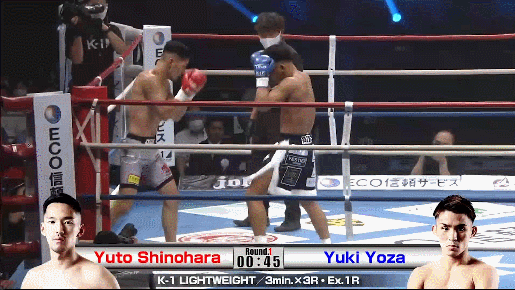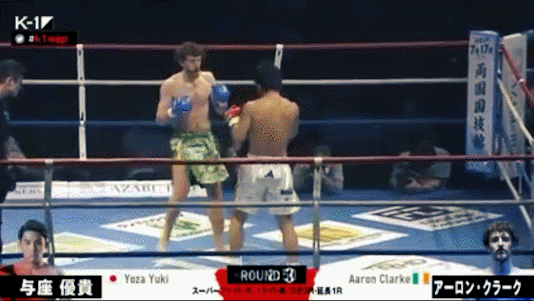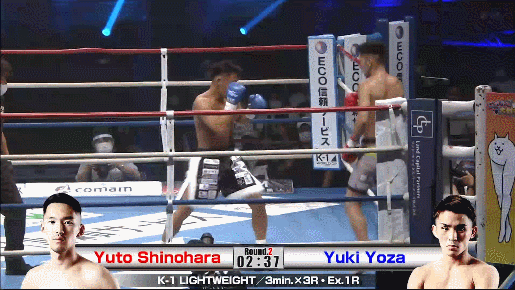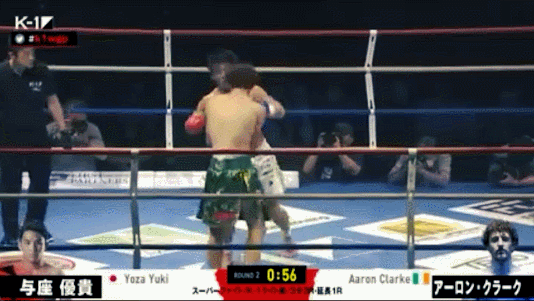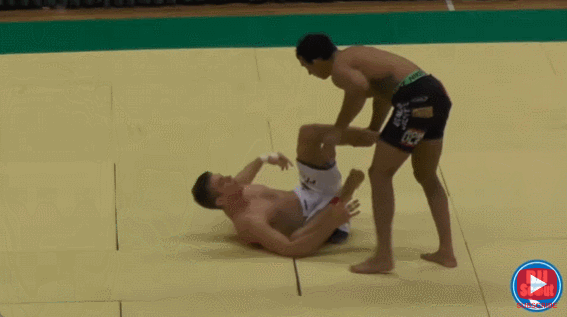Yuki Yoza and Polaris 24
Yuki Yoza is the K-1 lightweight champion and the consensus best fighter in the world at his weight. As is tradition in Japanese fight promotions, K-1 padded out the star power of their Saturday card with a Yoza non-title fight against a largely unknown and obviously overmatched opponent in Aaron Clarke.
While it might seem questionable to give time to examining an obvious “gimme” match, Yoza’s genius is in his offensive creativity and that was on full display here. All the sneaky little looks that Yoza usually makes use of were present, but so were a few he had clearly been working on in the lab.
If you have seen the clips of this fight posted on social media you will know that Clarke was often on the receiving end of five, six and seven strike combinations. But even overmatched fighters can put their guard up, walk forward, and get to swinging. The part that the highlights missed was how Yoza kept Clarke on the back foot. A large part of it was his lead leg teep.
Two weeks ago we discussed the “rhythm step” and how it has come to be demonized as an exploitable habit. This comes from a boxing centric view, because when you bounce your lead foot back after disengaging you leave your stance and abandon most of your weapons and defences. In sports that allow kicking, the rhythm step sets the feet for a powerful kick off the lead leg. Each time Clarke pressed in and Yoza gave ground, Yoza bounced his lead foot back to level with his rear foot, and into a powerful push kick that folded Clarke in half at the waist.
This is something that Joe Average could steal and make good use of. The part that is a little trickier is how Yoza can at any point turn over a high kick in the same space. Throughout the fight Yoza would come out of his rhythm step to show a push kick or body kick and turn it over to the head, and then promptly threaten to do it again and instead turn the kick from high to low, landing on the body.
One element that made Yoza stand out from the first time I set eyes on him was his targeting of the opponent’s back leg. This is something you will see a few crafty fighters do from time to time, but Yoza is unique in that his low kicking targets both legs almost equally. Yoza is helped by the variety of kicks that he uses to target the rear leg.
The first is a close range inside low kick. This is thrown from the same stance as the opponent, right leg to right leg. To land with the shin and avoid kicking the groin by mistake, the fighter has to get right on top of his opponent.
For this reason, Yoza throws this kick with his opponent against the ropes, immediately off of his left hook.
At a slightly greater range, Yoza will throw the same way—right leg kicking across at his opponent’s right leg—but with a front kick, landing the ball of his foot into the meat of his opponent’s thigh. This is the strike that has come to be called the “Yoza kick.” Since Yoza’s rise to prominence, any J-Kick event contains one or two fighters attempting the kick. Here is cruiserweight, Seiya Tanigawa—a fighter with only a couple of moves—attempting his first one in a professional fight and promptly scoring a knockdown.
Then there is Yoza’s work from southpaw. Perhaps the most powerful kick to the rear leg is an open stance, rear leg outside low kick and he used this a couple of times against Clarke. This kick was made famous by Andy Hug, who knocked out Mark Russell with it but was able to drop fighters as experienced and skilled as Ray Sefo with it.
Yoza is a Kyokushin world champion—the youngest ever having won it at just nineteen years old. Kyokushin is a peculiar sport wherein punches to the head are illegal but head kicks are encouraged. This leads to fights unfolding in tight, trading body punches and low kicks before throwing up the occasional head kick. Like Andy Hug before him, Yoza’s low kicking works around where his opponent’s weight is. Hug would often shove his man back out of a clinch in kickboxing and hammer the weighted leg that he knew they couldn’t pick up.
Here Yoza throws a front kick to the rear leg, stepping from southpaw into an orthodox stance and closing the range. He slaps in a left hook and then scores a clean calf kick that stumbles Clarke. The punt to the rear leg takes Clarke’s mind off his lead leg but also extends his stance, exposing the lead leg to the calf kick.
The same principle can be seen here against Yuto Shinohara. Yoza had been hammering the rear leg through the whole round, and finally threw a cheeky calf kick to the lead leg and caught Shinohara completely out of position.
There have been plenty of Kyokushin karateka who excelled in tight, constantly punching and feeling their opponent’s weight placement before hammering in a low kick—Hajime Kazumi is a great example as a man who basically refused to high kick. But most Kyokushin stand outs, when they get to kickboxing, have to relegate their existing skills to an auxiliary role. This is the most interesting part of Yoza’s success in kickboxing: he is doing a great job of turning his K-1 fights into Kyokushin matches by forcing his way to the infight.
The idea of off-balancing in the infight extends to Yoza’s punching game. In Kyokushin it is very common to punch with one leg in the air. Ryu Narushima had great success throwing a left high kick and poking in a body punch off the same side just after the kick hit the opponent’s guard. If we return to Jack Dempsey’s idea of pure punching, the blow could in no way be considered “pure” because the body is not in motion behind it. It is a partial punch but the placement and timing mitigate the lack of power.
The left high kick to left straight, while on one leg, was Andy Hug’s go-to technique when he arrived in K-1. Just three fights into his professional kickboxing career, Hug took on the reigning K-1 Grand Prix champion, Branko Cikatic, and used this technique almost exclusively in beating him. More recently, Lyoto Machida used it to drop Rashad Evans in the first real engagement of their UFC light heavyweight title fight.
Yoza has a slightly different look. He throws a round kick off one side, and hammers in an uppercut on the other while his foot is still in the air. Clarke was on the receiving end of it a few times. Sometimes Yoza fell into the clinch off it, another time Yoza pivoted out off it.
In this instance, Yoza used it to get back onto his sprinter’s stance, ready to throw the left hook and then, of course, the right low kick to Clarke’s rear leg. And so you see how it all comes together.
It’s a tricky little move and it works best from tight in. Yoza has hurt opponents with this technique before, while seeming to be completely out of balance at the time.
Last week we discussed Subriel Matias’ use of the body jab to get to inside position. It seems to work so well because his opponents expect a big overhand from a man who just wants to charge into infighting range, and it keeps his hands below theirs if they try to tie up. At several points in this fight, Yoza raised his lead leg as if to poke Clarke with the front kick again, and instead swung in an palm down left hook to the body, closing into the infight behind it.
In spite of the fight becoming one way traffic, Clarke made it to the final bell. If Yoza was supposed to bring in extra viewers, I don’t know how well it worked. But if the intention was to sit down the casual viewer and force them to reckon with the brilliant and still largely unknown Yuki Yoza, it was a noble exercise. I will continue to sing his praises as he continues to do new and exciting things as the K-1 lightweight champion.
Polaris 24
Polaris put on a no gi grappling event like any other. A few good matches, a few matches that devolved into bad wrestling, and a few interesting looks that the average grappling hobbyist might try to steal.
Jason Rau is often spoken of in glowing terms as grappling’s greatest under-achiever. He’s been in the best gyms with the best guys and is always one of the baddest men in the room, but his competition performance has often not reflected that. At Polaris 24 he got the chance to demonstrate his chops against Matty Holmes.
Rau is known as one of the great minds of the leg attacking game, and particularly for his reverse de la riva guard. The reverse de la riva was also called the “spiral guard” when it broke out about a decade ago, because the focal attack is an inversion where the bottom man spins on his back underneath the opponent’s base. This was used to attack the back with the “kiss of the dragon”, and you can watch Cobrinho do that to all of his opponents with little resistance back at ADCC 2011. Nowadays the inversion is mainly used to attack the legs.
Matty Holmes came out with the intention of not letting Rau get underneath him, so he squatted low into a combat base. His free leg was down on the floor to prevent Rau from getting underneath him, and he took a scoop grip on Rau’s free leg to gain some control over his inversion. Figure 1 shows how Rau overcame this
Fig. 1
Rau has his reverse de la riva (a) and uses his hook to push Holmes’ weight onto the far leg, which is kneeling on the mat (b). Holmes switches from a grip from Rau’s shoelaces to a scoop grip cupping the knee, giving him some control over the inversion and the ability to threaten his own attacks on that leg (c). But notice that Holmes’ weight being over his left leg allows Rau to extend Holmes’ right leg behind his elbow.
Figure 2 picks it up from another angle.
Fig. 2
Rau has partially inverted and drawn Holmes’ right ankle out (d). Holmes’ weight is now almost entirely on his left knee and hand. Rau draws his reverse de la riva hook back underneath him, necessary for standing up but also shelving Holmes’ ankle in the process and slowing Holmes down should he try to scramble up (e). Rau posts on his right hand, grabs Holmes’ other leg with his left hand, and performs a technical stand up to come up on top (f), immediately switching to a reverse grip with his right hand and beginning a high step pass.
This links with a technique that Keenan Cornelius called “the mollywhopper”. It was a sneaky sort of ankle pick that he employed from his reverse de la riva as opponents stood back to deny him their far leg. The most high profile outing it got was when he used it several times against Romulo Barral in ADCC 2013.
In the main event of Polaris 24, Mateusz Szczecinski was able to use this technique to take top position in the first minute, as seen in Figure 3.
Fig. 3
Szczecinski begins with Jed Hue in his reverse de la riva guard, on his right hip (a). As Hue is sitting back and not pressuring into the knee slice, Szczecinski can remove his reverse de la riva hook and place his right foot on Hue’s left thigh (b). As he does this he straightens his body out and squares up, allowing him to insert a regular de la riva hook (c).
Fig. 4
Szczecinski extends his de la riva hook into Hue and uses his right hand to pull Hue’s ankle in (d). As Hue’s weight leaves his lead leg, his foot comes off the mat and he cannot get his weight back onto it. Szczecinski pummels his right foot over the top of the ankle he is picking and places it on the mat (e). This allows him to stand up while keeping Hue’s foot elevated (f).
A final notable moment came from Ethan Crelinsten, who we studied before in Combat Jiu Jitsu and the State of Grappling in MMA. In that article we discussed his use of the body triangle from mount to hold down and batter his opponent. The neat part of it is that if his opponent catches his free ankle and begins to elbow escape back to half guard, his left foot is backstopping his right knee and prevents the escape.
Fig. 5
Against Nathan Orchard, in a non-combat jiu jitsu match, he was able to make use of the same position. Figure 6 shows how Orchard raising his hips (a) allows Crelinsten to sneak his left foot underneath and into the back of his right knee. In the Combat Jiu Jitsu worlds he entered the mounted body triangle by coming up from a back body triangle, but against Orchard he transitioned straight there from mount. Then Crelinsten pummeled his own free foot between Orchard’s legs and encouraged that elbow escape position with Orchard’s hips on one side (b, c, d).
Fig. 6
Orchard hit on the right idea by using the top of his right foot as a hook to force Crelinsten’s foot away and break the lock, but he still spent the entire match being crushed. It is also quite a lot to ask that a fighter remember how to unlock the body triangle if he is being hit in the head from mount.
Fig. 7
In an MMA landscape where fighters are getting stuck with back control but no real threat of finishing the fight, it would be a treat to see them adopt the transition to the mounted body triangle as Crelinsten uses and as Rafael Lovato used against regional legend, Gegard Mousasi.





